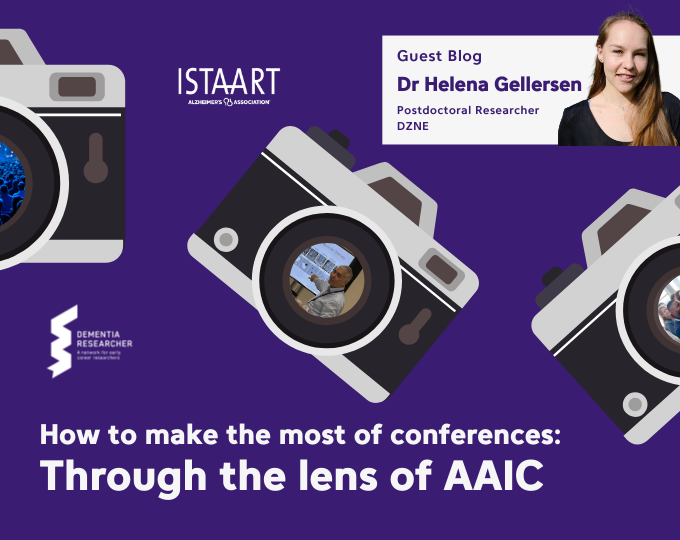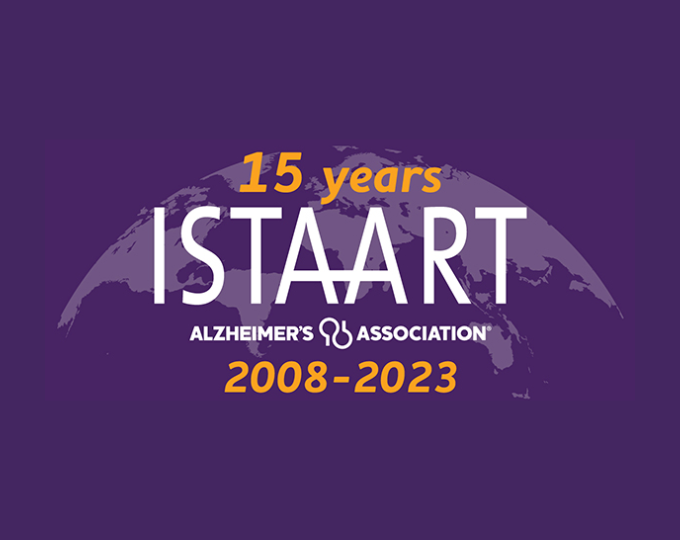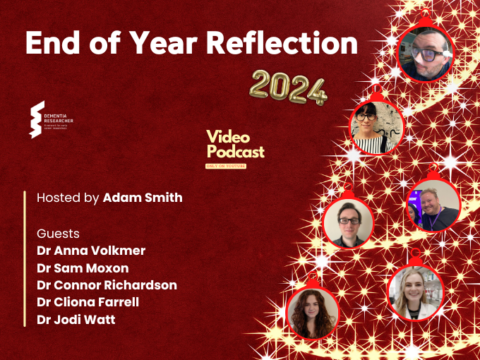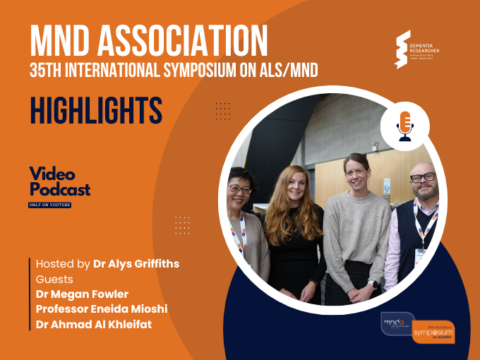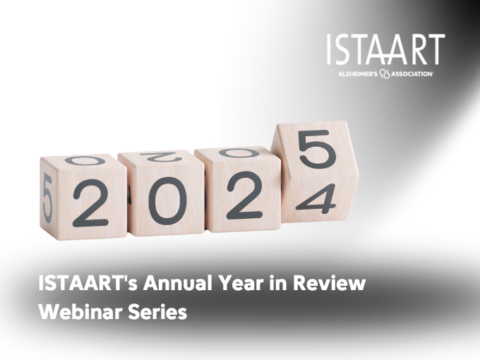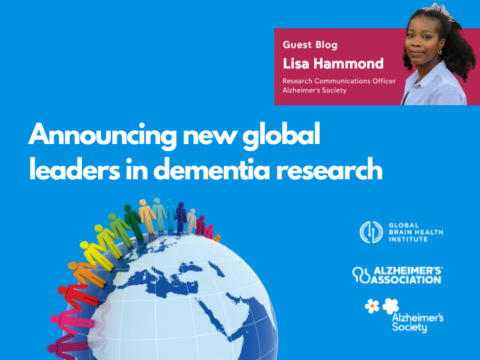Join us for another episode of the ISTAART Relay Podcast brought to you by Dementia Researcher. We’re releasing one of these shows each week in the build up to the AAIC, which this year starts on the 28th July.
In this episode, Dr Diana Karamacoska takes over the hot seat to interview Dr Keir Yong, a Senior Research Fellow at University College London, about the intricacies of Atypical Alzheimer's Disease, and the work of the Atypical Alzheimer's Disease PIA.
Discover how posterior cortical atrophy (PCA), a less common variant of Alzheimer’s, impacts patients' lives and the innovative research aiming to improve diagnosis and treatment. Get insights into the diagnostic challenges, the role of biomarkers, and the essential interdisciplinary collaborations driving advancements in this field.
Don't miss this deep dive into Keir’s work, hot topics in the field, and how their PIA is making a difference.
Voice Over:
Hello, and thank you for listening to the fifth season of the ISTAART PIA Relay Podcast, brought to you by Dementia Researcher. ISTAART is a professional society and part of the Alzheimer's Association representing scientists, physicians, and other dementia professionals active in researching and understanding the causes and treatments of Alzheimer's disease and other dementias. In this six-part series, we have members of ISTAART professional interest areas taking turns at interviewing their colleagues and being interviewed themselves with the interviewee going on to be the next episode's interviewer. We're sure you've listened before, so you know what to expect. We'll be releasing one of these podcasts each day in the build-up to the Alzheimer's Association International Conference, which this year takes place in Philadelphia. Through the series, we hope you'll learn more about some of the amazing research happening in different fields of discovery and about the great work taking place in the ISTAART PIAs. Thank you for listening.
Dr Diana Karamacoska:
I'm Diana Karamacoska, a cognitive neuroscientist by trade and brain health advocate by heart. I work at Western Sydney University in Australia. And I'm also very lucky to be working on the partnering with research participants peer as the vice chair or incoming chair. Today, I'm super delighted to be talking with Keir Yong from the Atypical Alzheimer's Disease peer. Hi, Keir. Can I start by asking you to introduce yourself and tell us which peer you're involved with?
Dr Keir Yong:
Hi, Diana. My name is Keir Yong. I'm a Dunhill Medical Trust Senior Research Fellow, and I'm vice chair of the Atypical Alzheimer's Disease peer.
Dr Diana Karamacoska:
So, we've got two vice chairs in the room. Could you tell us a little bit about your own research and what brought you into the field of dementia?
Dr Keir Yong:
So, I originally started working with people with the diagnosis of dementia in long-term care and day centre settings, evaluating the effects of psychological interventions really to promote functional independence. I've since spent most of the last 15 years at University College London Queen's Square Institute of Neurology, where I worked with people mainly with younger onset forms of Alzheimer's disease, these include forms of both inherited and sporadic. And in particular, I work with people diagnosed with a condition known as posterior cortical atrophy that often people consider to be the canonical visual form of dementia. So, people will use terms such as visual variant or visuospatial Alzheimer's disease. And I currently lead the UCL study of posterior cortical atrophy. Now, as part the UCL programme of research, regarding posterior cortical atrophy, we take a multi-pronged approach. Unfortunately, owing to the nature of their atypical visual, rather than predominantly memory-led presentation, people with PCA face particular challenges getting to an accurate and timely diagnosis. So many people who I work with have spent years going from one, say, eye health professional to the other, but that not necessarily prompted for all to see a dementia specialist.
And so, a lot of the work that we do is an improving diagnosis of posterior cortical atrophy, both working with eye health professionals, but also working with neuroimaging specialists. Unfortunately, many of the symptoms associated with damage towards the very back of the brain, so posterior cortical atrophy itself essentially means back of the brain shrinkage, have quite dramatic implications for people's day-to-day independence. So, we also conduct a body of work, which is on better developing management strategies to support people. So, a lot of this is focused on developing assistive technology to promote things like independent reading for someone who has dementia-related visual loss, as well as developing environmental adaptations to support things such as people's mobility, their balance, and their hand-eye coordination. And finally, some of the research that we conduct to better understand the cause of posterior cortical atrophy involves a range of professionals, some of whom specialise in, for example, molecular neuroscience or biofluid biomarkers, as well as underlying pathology. And this involves working with people, again, from various groups across University College of London and the Queens Brain Bank.
Dr Diana Karamacoska:
Incredible. Oh, my goodness. There's so much to unpack with that. I feel like what you do is really impactful and would involve a lot of interdisciplinary teams. So, I guess, maybe a question for some of our audience members who are listening in. We know that Alzheimer's disease is considered the most common type of dementia. Where does this posterior dementia fall in terms of prevalence or how often it occurs?
Dr Keir Yong:
It's a great question. And I think it's fair to say there are estimates on what proportion of people with Alzheimer's disease in general have this so-called visual or visuospatial-led form are based off a relatively small number of studies. And often these studies are from quite specialist centres. These previous studies would put something, say, like anywhere from about 8 to 13% of people with Alzheimer's disease to have an initial presentation, which is in keeping with that posterior cortical atrophy. So again, with initial changes to do so with people's difficulty in their driving, their reading, difficulties perceiving what or where things are despite them being in clear view, as well as other symptoms which are consistent with the vulnerability of particularly posterior parietal regions, such as difficulty with people say calculation, spelling, and praxis skills.
However, I should note as well that the separate work coming out from centres in the states that suggests in large data sharing initiatives that perhaps anywhere between 10 to 16% of patients might either have predominant visual versus memory symptoms. But the differences are more subtle than that, in which, we see in posterior cortical atrophy. And these are people with predominantly late onset forms of Alzheimer's disease. While for reasons we don't fully understand at this point, people with posterior cortical atrophy and other atypical memory-sparing forms of Alzheimer's disease are overrepresented in people whose age onset of Alzheimer's disease is below the age of 65.
I should also mention that some of the work done by more of the data scientists and neuroimages perhaps suggests that anywhere between a quarter, perhaps up to a third of people from data sharing initiatives have particular vulnerability of the posterior parietal and occipital regions, despite relative sparing of so-called Alzheimer's disease signature regions, such as the medial temporal lobes. And this is basically either off Tau PET or MRI. And again, this might be another way of thinking about, again essentially, how you might see posterior cortical atrophy as an extreme point of variation in the wider Alzheimer's disease phenotypic space.
Dr Diana Karamacoska:
Fascinating. And so, you're saying this tends to affect people in the younger age groups. What does that diagnostic process look like, because they're presenting with certain symptoms, but then how do you go through that process of confirming that it is a type of Alzheimer's disease or implicated in that?
Dr Keir Yong:
So, a common diagnostic scenario for people with PCA involves initially going to see an eye health professional, not always, but at least based off the UCL participant experience, the majority of people will initially see, again, it might be a community optician or optometrist and say, "Look, I've got these somewhat nebulous difficulties with aspects of my vision. It could range from things like an exaggerated sensitivity to incoming headlights at nighttime. It could also extend to things like difficulty maintaining my place on a page while reading, or certain texts jumbling, or cluttering up." Or for other people, it could be difficulty with things like certain buttons, clasps, or zips during dressing. This, in some cases, might raise suspicion of, say, a cortical visual, i.e., brain site, rather than eyesight issue, based off, again, a number of different procedures that are conducted by the eye health professional, which will rule out an afferent visual cause. So, say something that's going on at the level of the retina or the optic radiation, say.
But unfortunately, in some cases, people might spot some co-occurring eye conditions. So, say someone sees a cataract and say, "Well, it might be that. So, let's go in and operate. And that might address some of the visual symptoms that people are reporting." But what that can do in a lot of people's experiences is just delay their eventual diagnosis really by period of years. Unfortunately, for other people, and this is whether they're presenting to eye health professionals or say psychological services, people may be told that they're burnt out from work in line with, again, a PCA tending to be experienced mostly in people with young onset forms of Alzheimer's disease.
Other people may be diagnosed with a psychiatric disorder. So, people may say, "Look, this might be to do with some anxiety or stress." Maybe to do with the time of life that people are at. And there's some initial suggestions, although I don't know this has been formally published, that actually women with PCA might be more susceptible to this notion that, "Oh, if we can't determine that it's arising from an eye condition, it therefore must be psychological, rather than perhaps be neurological in the form of a neurodegenerative process."
And in terms of actually making a diagnosis of PCA, so there's only one set of consensus criteria for PCA, and this has been enabled through the Atypical AD peer and the PCA work groups. But PCA is essentially defined as a clinical radiological syndrome. So, it can have multiple different underlying causes, but by far the most common cause is Alzheimer's disease pathology. So, at the syndrome level, PCA will be diagnosed based off, again, establishing that it's neurodegenerative in origin, and a number of core clinical and cognitive features, some of which I've touched upon. But then, also with supportive imaging features where available. And often the PCA diagnosis is substantiated as well by accompanying MRI scans, which indicate, again, actually particularly a parato-occipital or occipital temporal regions. But in terms of getting to a disease level diagnosis, so fulfilling criteria for, say, PCA-AD, rather than solely PCA. As with other forms of Alzheimer's disease, this really relies on in-vivo biomarkers. So, for example, a lumbar puncture might be amyloid or Tau PET and some very specialist centres, but increasingly, there's a lot of excitement about the move to more accessible plasma biomarkers.
Dr Diana Karamacoska:
Okay. Well, that was going to lead into my next question for you, which was around what are some of the hot topics within your field? So, I'd love to learn more about those plasma-based biomarkers. Can you shed some light on that?
Dr Keir Yong:
Sure. Well, I think one of the key questions here is, particularly given how there's really very limited work out there on biofluid biomarkers in atypical forms of Alzheimer's disease in general, whether again, plasma biomarker profiles are indeed going to be consistent or comparable between people with both atypical and typical forms of Alzheimer's disease. In the past years, we have had people from UPenn presenting on this. I should also mention that for our featured research session at this year's AIC, we will have a presentation from Amsterdam UMC on, again, biofluid profiles, but across Alzheimer's disease spectrum, not necessarily focusing on these clinically defined atypical phenotypes. Other very, as you say, hot topics at the moment really relate to the anticipated, well, access to disease modifying therapies for Alzheimer's disease. So, this is, again, particularly urgent based off reasons I've discussed regarding challenges getting to a timely diagnosis.
So, given how, for example, people with these atypical forms are more likely to present to services outside memory services, given how they're overrepresented in people with young forms of Alzheimer's disease, some studies might suggest it could be perhaps a third of people with young onset Alzheimer's disease have these atypical, i.e., non-memory led forms, compared to say, as little as 5, maybe 10% of people with late onset Alzheimer's disease, that it raises these quite sobering challenges about how in scenarios where people might be, again, prescribed, again, these anticipated disease modifying therapies targeting amyloid, that actually, by the time that many people with atypical Alzheimer's disease are actually getting to a formal diagnosis, people might consider it to be too late for them to really stand to benefit. And that might be despite the fact that given how they tend to have younger age at onset, they might have less comorbidities which can be considered as contraindications for these anticipated therapies.
I want to highlight a good example about where the Atypical AD peer has really facilitated some of this work, both on emphasising diagnostic challenges while simultaneously emphasising, again, their preponderance of underlying Alzheimer's disease pathology, that about three months ago, Marianne Chapleau and other researchers from UCSF facilitated by the Atypical AD peer and PCA work group published the largest study of PCA to date. So, this involved over 1000 people with PCA seen worldwide. And this is essentially pooling clinical and pathological data from a number of international centres. Some key messages for this work were again, that perhaps there was evidence of Alzheimer's pathology, about 90% of people with PCA.
However, people's age of onset was mostly in their late-50s. And the average time between symptom onset and formal diagnosis was in the region of, say, four years. And, this article got a lot of coverage in international media, in media such as the Washington Post, Le Monde, and Newsweek, with headlines such as, Alzheimer's disease may start with "weird visual problems." But we were appreciative of some of the coverage in the wider media, because for a great number of professionals, certainly myself when I was working initially in long-term care settings, they might not be aware that Alzheimer's disease may cause any visual symptoms. Whereas, of course, for many people with PCA, or the majority, it's really some of the first signs of them having Alzheimer's disease.
Dr Diana Karamacoska:
Well, congrats to the peer for making this publication happen. That's an incredible feat. Can you speak a little bit more about how the peer has helped your own field of research? So, furthering this work, have there been additional work groups, or symposiums, special conference events or workshops?
Dr Keir Yong:
Certainly. So, I can't emphasise enough how central the atypical ad peer and also the PCA working party have been in advancing the field of atypical Alzheimer's disease research. So, this stems back to things like the development of the ONI consensus classification criteria for posterior cortical atrophy. I think, relevant to your peer, the partnering with research participants peer, in part, the development of these criteria stemmed from people with posterior cortical atrophy who were saying things like, "So, my neurologist in Manchester would consider PCA to be X. Whereas, another neurologist in, say, London or maybe in Toronto might have different definitions about the boundaries of the PCA syndrome. Don't these professionals talk to one another?" And also, some inconsistencies in terminology. What held back the field for a while, was some people refer to things like visual variant Alzheimer's disease and consider PCA to be exclusively an atypical form of Alzheimer's. Other people would use the convention of referring to PCA based off the neurologist who first coined the phrase that was Frank Benson. And other people would use even more colloquial terms.
But the consensus criteria to date have also facilitated a number of large multicentre studies. I'd mentioned the one led by Marianne Chapleau published in the Lancet Neurology. But other examples include the largest study of genetic risk factors associated with PCA. The largest study of PCA progression and multicentre working and recommendations to improve both diagnostic tools for PCA. And also, consider more tailored management approaches. And all of these, again, have been facilitated by the Atypical AD peer and the linked PCA work groups. I should also mention that a key role of the peer has essentially been furthering our understanding about why Alzheimer's disease may affect different people often in very different ways. Going back to your question about some very pressing topics in the field, there's this recurring puzzle, whereby in general, APOE e4 for which might be considered the strongest genetic risk factor for sporadic Alzheimer's disease, tends to be associated with younger age at onset.
So, based off how many copies of the APOE e4 annual one has, people might on average have their onset, say, in their 60s, 70s, or later, however, different work from a number of centres, again, relating to the peer, has provided evidence that not only do people with atypical forms of Alzheimer's disease, particularly visual language and perhaps motor-led presentations tend to have a younger age at onset, but that's often in the absence of the APOE e4 annual. So, another way to think about this, at least in the context of posterior cord hypertrophy, is that the risk effect associated with APOE e4 is smaller for posterior cortical hypertrophy, relative to people with more typical Alzheimer's disease. And that's despite this over-representation of posterior cortical atrophy in young onset Alzheimer's disease cases. And so, I think, some of the work that's being done and is showcased regularly as part of the atypical peer, really provides us with a key opportunity to better understand what some of those other factors are that influence essentially the type of Alzheimer's disease that someone develops.
Dr Diana Karamacoska:
It's really fantastic to hear that you've made such big inroads in the clinical space through the peer, especially in terms of getting consensus around those guidelines for diagnostic purposes and for assessment. And I absolutely love that you're forming a lot of your work around what you're hearing from your research participants or patients on the ground. Can I ask a question about whether you've been involved in any co-designed research, or have you partnered with research participants yourself?
Dr Keir Yong:
Certainly. So, I should say that really all this friends of research that I was outlining [inaudible 00:21:55] University College London, really originated from conversations with people with posterior cortical atrophy. Again, their friends, their family, both the people attending clinic, and also through support group meetings that we regularly organise. And that's through an organisation called Rare Dementia Support, which has an international membership. So, as just some quick examples regarding co-design. So, we've co-designed educational materials, raising awareness of posterior cortical atrophy, not only amongst I-Health professionals, but also with community-based care professionals, so people like occupational therapists might be supporting people in their own homes. We've also co-developed assistive technology. This has involved actually working with a few people with posterior cortical atrophy who themselves had a background in software development to develop an app, which is called ReadClear, to promote reading as an independent activity into the course of posterior cortical atrophy with reading loss being quite a debilitating consequence of, again, posterior cortical atrophy.
And some of the work that I'm currently conducting is better understanding some of these more counterintuitive changes, not so much in visual perception, but really in space and body perception. So, again, things which can really affect our ability to get around, say, at nighttime in pitch black, or they can present in clinic as someone who might have difficulty finding the sleeve of a jacket behind themselves while getting dressed or have difficulties confidently transferring from standing to sitting. So essentially, disturbances in their spatial awareness, which lack explicit visual components. But the reason why we are research into these symptoms, and ultimately, how to better manage them is because people, PCA saying, "These are the things that do limit my confidence and my ability in just navigating everyday settings."
Dr Diana Karamacoska:
Wow, that partnership is so essential, and it sounds like you're really doing your best to empathise and appreciate the lived experiences of these individuals, and harnessing maybe some of the skills and professional experiences that they bring to the table. Little bit shifting gears now. I'd love to learn more about how your peer actually operates. And how do you get organised? And what opportunities are there for your members to get involved in some of your activities?
Dr Keir Yong:
So, we have, similar to other peers, a great executive committee comprising our past chair, chair, vice chair programmes, and communications chair, and we also have a junior trainee role. But in addition to the executive committee, we have, again, at this point, one regular work group meeting that's focused on posterior cortical atrophy. And we actually have an intermission session at Alzheimer's Association's International Conference this year on the Wednesday, which people are welcome to attend. So, this will be an in-person PCA work group meeting. But on top of that, we do regularly survey the membership. So, for example, what tools they found most helpful to make a diagnosis of atypical forms of Alzheimer's disease, or noting where there might be gaps in existing tools. And some other work that people can participate in and have, again, generously supported in the past is with things like data sharing, because it might be that each individual centre might see perhaps a dozen or several dozen people with these atypical forms of Alzheimer's disease. Again, owing to challenges in getting to a diagnosis as well as the relative rarity of some of these forms.
So, it might be to conduct certain types of research. It really demands a multi-centre working. And that's something which, again, we have an increasing track record doing, ranging from genetic samples in the past to regional measures of Tau deposition that's based off brain tissue or based off Tau PET. And, as I mentioned, also clinical pathological data extending all sorts of things, like biofluid measures.
Dr Diana Karamacoska:
There's actually so much happening within your peer. And I feel like it's a fantastic opportunity for members to get involved in some multinational collaborations, and also really pushing the field forward to address those knowledge gaps or knowledge to practise gaps that we're hearing about. Can you tell me what you're going to be doing at AEIC this year? Besides the intermission session, is there anything else that the peer is facilitating?
Dr Keir Yong:
Thank you. Yes. So, you'd mentioned the intermission session, which will be focusing on both revisiting the ONI consensus criteria for PCA, but in light of some very exciting recent clinical and research advances, we talked about things like the, again, anticipated availability of both, disease modifying therapies, as well as things like plasma biomarkers. And I think, increasing recognition as well that co-pathology might really be the rule, rather than exception even in people with younger onset forms of Alzheimer's disease. We're also going to be considering opportunities for sharing test materials to better diagnose, again, these atypical forms of Alzheimer's, particularly in this instance, posterior cortical atrophy. And we'll talk about opportunities for data sharing to address current clinical and research gaps. But besides the intermission session, we're also having our regular scientific session on this Saturday. And we've just confirmed that there should be six presentations due from international centres. And, on the Sunday, we are very pleased to have our featured research session. So, this, again, will be the official ADFRS.
We have an international lineup of speakers from Buenos Aires talking about MRI profiles in people with language-led forms of Alzheimer's disease. But also considering how the profiles of language impairment might vary depending on a country. We have myself who's presenting a new brain site test that I've developed for the UK Biobank study, ultimately to better detect early signs of posterior cortical atrophy in eye clinics. And I'll be talking about some changes in perception of both body as well as visual information. And, we have two speakers, one from Amsterdam UMC, who will be covering, again, biofluid measures in people varying in their Alzheimer's disease presentation. And finally, we'll have work on glial responses in both atypical and typical forms of Alzheimer's disease, and that'll be delivered by the Mayo Clinic.
Dr Diana Karamacoska:
Incredible. It sounds like a very juicy lineup. So, I'll try and make it over to your session on the Sunday. Final thoughts. Can you tell our listeners why they should join your peer?
Dr Keir Yong:
So, the Atypical AD peer, I would consider it the best forum for considering how Alzheimer's disease may affect different people often quite differently, considering the implications of Alzheimer's disease heterogeneity for people's care and support. But also, ultimately, in asking those fundamental questions about why one disease can affect people in such different ways.
Dr Diana Karamacoska:
Thank you so much for your time today. Do you feel like there's anything that you want to share with the listeners that I didn't get to ask you about, or that we didn't get to talk about today?
Dr Keir Yong:
I think, all I would like to do is just give a shout-out as well to the Atypical AD membership. Obviously, I'm biassed. But I think there's a real, as you put it, interdisciplinary mix of people. We have everyone, ranging from clinicians, and that's a broad range of clinicians, from allied health professionals, to neurologists, to psychiatrists, and geriatricians. We have, again, a consistent group of neuroimaging specialists who have a particular interest in atypical Alzheimer's. But we also have, again, incredible pathologists as well who have provided this seminal work on better understanding some of the mechanisms underlying Alzheimer's disease heterogeneity. And again, a range of people increasingly from data science, and again, biofluid biomarker backgrounds.
Dr Diana Karamacoska:
Such a mix. Honestly, it's really impressive how you managed to pull together so many people from different fields and different parts of the world to contribute to your peers’ efforts. Okay. Thank you all for listening. You can find the profiles of myself and my brilliant guest and information on how to become involved in the ISTAART on our website at dementiaresearcher.nihr.ac.uk, and also at www.als.org/ISTAART. There is a link in the show notes. I'm Diana Karamacoska, and you've been listening to the Relay Podcast from Dementia Researcher and the Alzheimer's Association. Hit subscribe on YouTube or on your favourite podcast app to ensure you don't miss an episode. Thank you so much. Bye.
Voice Over:
The Dementia Researcher Podcast was brought to you by University College London with generous funding from the UK National Institute for Health Research, Alzheimer's Research UK, Alzheimer's Society, Alzheimer's Association, and Race Against Dementia. Please subscribe, leave us a review, and register on our website for full access to all our great resources, dementiaresearcher.nihr.ac.uk.
END
Enjoyed the podcast? Please review, like, and share - and don't forget to subscribe to ensure you never miss an episode.
If you would like to share your own experiences or discuss your research in a blog or on a podcast, drop us a line to dementiaresearcher@ucl.ac.uk
Did you know... you can find our podcast in your favourite podcast app on mobile devices, and our narrated blogs are also available as a podcast.
This podcast is brought to you in association with the Alzheimer's Association, Alzheimer's Research UK, Race Against Dementia and Alzheimer's Society, who we thank for their ongoing support.
The views and opinions expressed by the host and guests in this podcast represent those of the guests and do not necessarily reflect those of UCL or Dementia Researcher

 Print This Post
Print This Post



